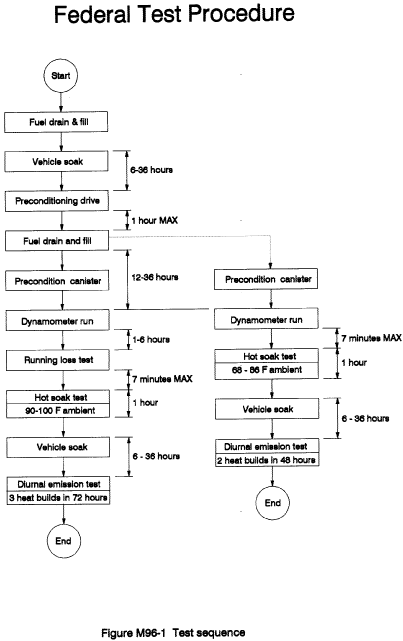 |
Code of Federal Regulations (Last Updated: November 8, 2024) |
 |
Title 40 - Protection of Environment |
 |
Chapter I - Environmental Protection Agency |
 |
SubChapter C - Air Programs |
 |
Part 86 - Control of Emissions from New and in-Use Highway Vehicles and Engines |
 |
Subpart M - XXX |
§ 86.1230-96 - Test sequence; general requirements.
-
(a)(1) Gasoline- and methanol-fueled vehicles. The test sequence shown in figure M96-1 of this section shows the steps encountered as the test vehicle undergoes the procedures subsequently described to determine conformity with the standards set forth. The full three-diurnal sequence depicted in figure M96-1 tests vehicles for all sources of evaporative emissions. The supplemental two-diurnal test sequence is designed to verify that vehicles sufficiently purge their evaporative canisters during the dynamometer run. Sections 86.1232-96, 86.1233-96 and 86.1238-96 describe the separate specifications of the supplemental two-diurnal test sequence.
(2) Gaseous-fueled vehicles. The test sequence shown in figure M96-1 of this section shows the steps encountered as the test vehicle undergoes the procedures subsequently described to determine conformity with the standards set forth, with the exception that the fuel drain and fill and precondition canister steps are not required for gaseous-fueled vehicles. In addition, the supplemental two-diurnal test and the running loss test are not required.
(b) The vehicle test for fuel spitback during fuel dispensing is conducted as a stand-alone test (see §86.1246). This test is not required for gaseous-fueled vehicles.
(c) Ambient temperature levels encountered by the test vehicle shall be not less than 68 °F nor more than 86 °F, unless otherwise specified. If a different ambient temperature is specified for soaking the vehicle, the soak period may be interrupted once for up to 10 minutes to transport the vehicle from one soak area to another, provided the ambient temperature experienced by the vehicle is never below 68 °F. The temperatures monitored during testing must be representative of those experienced by the test vehicle.
(d) The vehicle shall be approximately level during all phases of the test sequence to prevent abnormal fuel distribution.
(e) If tests are invalidated after collection of emission data from previous test segments, the test may be repeated to collect only those data points needed to complete emission measurements. Compliance with emission standards may be determined by combining emission measurements from different test runs. If any emission measurements are repeated, the new measurements supersede previous values.

[58 FR 16054, Mar. 24, 1993, as amended at 59 FR 48524, Sept. 21, 1994; 60 FR 43902, Aug. 23, 1995]